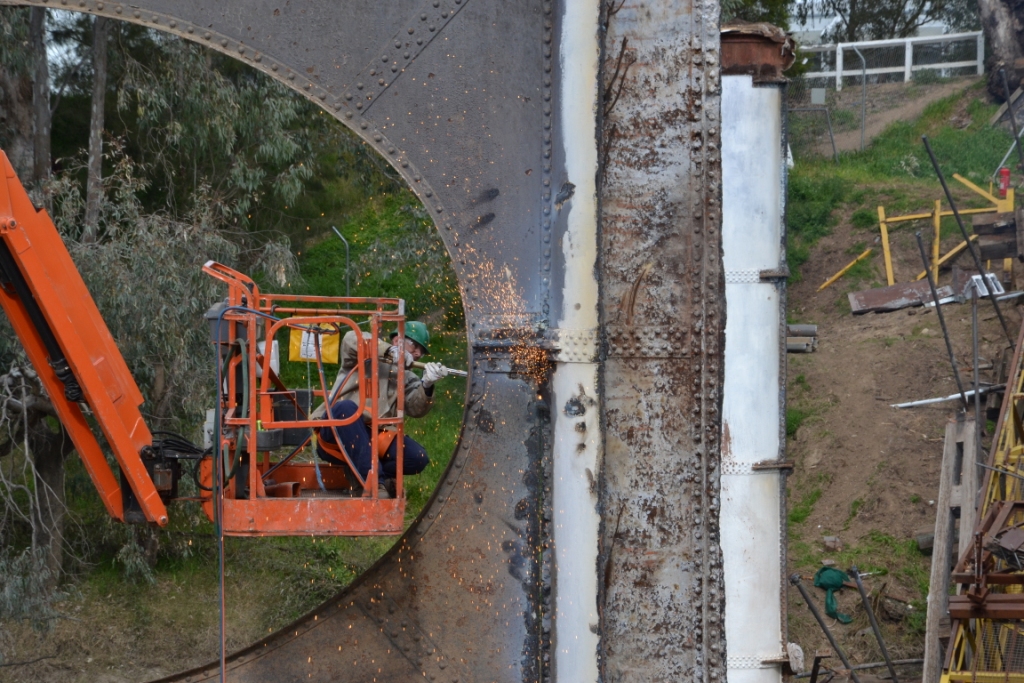The Hampden Bridge demolition was undertaken in 2014. Find out more about the Hampden Bridge Legacy Project.
23 October 2014

As of Friday afternoon 17 October, the works have been completed and the contractor has demobilised from site. Following completion of river works, the barges were dismantled into their component units at Wiradjuri Beach. A 200 ton crane was used to lift the units from the water onto low loaders.
The remaining pier 3 pylon set on the east bank had some damaged and missing copings, which are the caps at the top of the piers. Some copings had been retrieved from the demolished piers and these were used to repair the tops of the retained piers.
The abutment B girders and piers at the eastern end of the job have been removed and an earth bank has been formed at this location. Landscaping contractors have planted out an avenue of trees along the line where the edges of the bridge were, while the soil across the entire site has been scarified and seeded following reshaping to its natural shape to promote revegetation.
October 8 2014
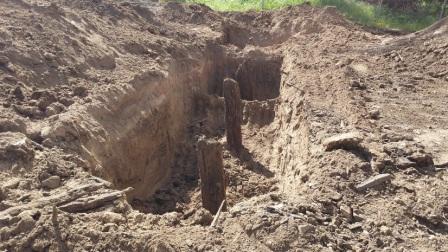
Following removal of the bulk of the pylons after last weeks' concrete fracturing, professional divers have spent Tuesday scouring the bottom of the river bed looking for any debris that the excavator on the barge may have missed. Some additional items were found and these were retrieved.
The divers will provide a report to verify that the river bed is clean of any further bridge pieces.The last load of bridge debris has been removed from the barges and with that the barges work is finished. The barges have today been floated down to Wiradjuri beach where they are being dismantled into their component units and being moved on to their next job. The river channel is now re-open to all maritime vessels.
The job is winding up very quickly now. With only approximately one week of work left, the site shed left site today. Most of the bridge materials have now left site, with a small assortment of concrete and steel remaining to be removed from site.
One of the final remaining tasks involves removing the remnants of the approach span piers to one metre below ground level. As they are being exposed, these piers are being found to be in poor condition. (refer picture)
As the contractor moves out of the site, any remaining remnants of timber and other debris are to be collected and disposed of. Minor reshaping of the soil is to take place ahead of some tree planting and sowing of grass seeds to protect the exposed earth.
1 October 2014
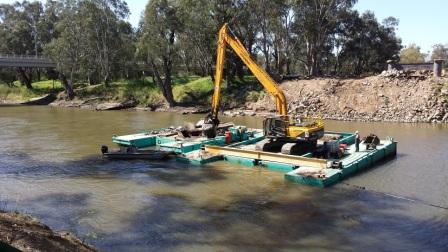
Demolition of the 3 remaining pylons in the river was undertaken using a concrete fracturing technique on 30 September. The technique involved drilling a central hole down the centre of each pylon to a depth of approximately 4 to 5 m below water level and the placing of small explosive charges. The charges were detonated which has resulted in the fracturing of the concrete and the cast iron sections of pylon into manageable fragments. (refer photo)
The pylon stubs had protective blast matting laid over the top prior to blasting as a safety precaution.
With the pylons now demolished, the contractor has already commenced removal of the fragments. Once this has been completed, professional divers will inspect the river bed floor as a final check to ensure all bridge debris has been removed. Once this task has been completed, the barges will be demobilised and leave site.
Other work during the week has involved sorting and removal of waste. Concrete from the pylons and metal are being recycled. The amount of bridge materials remaining on site is now diminishing very rapidly, and the contractor will soon be able to commence rehabilitation of the disturbed ground, which culminates in revegetation.
29 September 2014
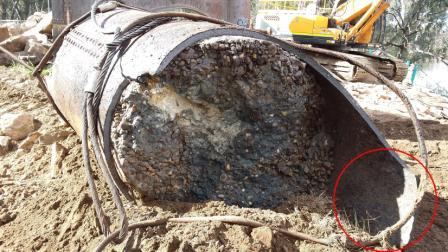
Over the course of the next week, the contractor undertaking the demolition of Hampden Bridge will be using a number of small explosive charges to fracture the remaining sections of the pylons. This has become necessary due to concerns about the ability to remove the pylons cleanly below the river bed level with the potential for leaving a sharp section of casing below the waterline (refer photo above of a section of pylon broken back with an excavator mounted hammer). This possibility was identified at the time that the s96(2) modification was lodged for the induced collapse by explosive and application made accordingly. On determination, consent was granted to use explosives for the demolition of the pylons.
The blasts will be very small in nature and will require the implementation of a much smaller exclusion zone than was required for the induced collapse. As a result, there will be no impact on the public in Fitzmaurice Street, with only very brief and minor detours for pedestrians using the walking track adjacent to the river. The blasts will occur below the water line. As a result, it is unlikely that they will be noticed, either visibly or audibly, by anybody not immediately involved in the work. WorkCover, Maritime Services and Fisheries have been notified and have made no objection. A technique known as fish scare (an extremely small detonation below the surface of the water immediately prior to the blast) will be employed to ensure that fish and other fauna are not harmed by the blast.
24 September 2014
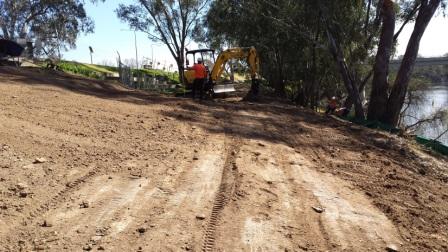
The west bank has been completely cleaned up of all bridge materials and has had minor earthworks reshaping undertaken. Materials recovered have been loaded onto the barge which has then been floated to the eastern bank and unloaded for disposal. The Contractor will during the next few days spread topsoil and grass seed on the newly shaped earth to stabilise and revegetate.
The works in the river are almost complete. The river bed has been explored with a sieve bucket and any bridge debris has been removed.
The remaining work in the river involves demolition of the piers and removal of resultant debris. This work is expected to occur during the next week. Once this has occurred, the barges will be floated down to Wiradjuri beach where they will be disassembled and demobilised.
The Contractor continues to dismantle truss members and remove them from site, as well as disposing of other waste materials such as bridge steel and general waste including timber.
17 September 2014
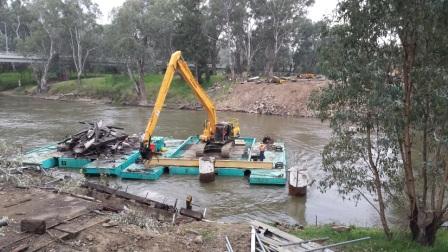
The remaining 3 pylons in pier sets 1 and 2 have been removed down to approximately 1m above water level.
The Contractor moved the barges down to Wiradjuri beach on Friday to allow the boom lift (elevated work platform) to be removed altogether as it is no longer required.
The 30 tonne excavator was also removed and the long reach excavator installed on the barge. This allows greater capacity for the long reach excavator to retrieve materials from the western bank and also from the river bed.
Works over the last couple of days and for the next week are basically quite repetitive and involve removal of the remaining materials and placed on the barge. The barge is then moved to the east bank where it is unloaded and disposed of.
The remaining pylon stubs will be removed during the next week to 1 metre below bed level. Once this is done, the bridge is effectively completely demolished.
The Contractor continues to dismantle truss members and remove them from site. Council is also salvaging examples of each type of truss member for posterity.
Contractor activities will soon narrow down to removal of all materials from site and then rehabilitation of the site in terms of minor reshaping of the site and revegetation.
9 September 2014
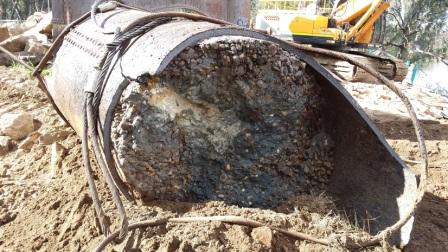
The downstream pier of pier set 2 has been completely removed. There was a considerable amount of interest as to what the quality of the concrete inside the piers would be. The concrete was generally quite hard however showed a high degree of segregation, that is there was a lot of larger stone aggregate around the outside of the iron casing, rather than the entire concrete structure being uniformly mixed. This is likely to have occurred due to concrete mixing practices in 1895 not being what they are today, and also the concrete was likely dropped into the casing from a height, which contributed to the segregation.
A high degree of corrosion has been noted in both the wrought iron and cast iron sections of the casing.
The cast iron and wrought iron casing sections have been inspected by a NSW Roads and Maritime Services (RMS) Engineer as it is a rare opportunity for RMS to inspect the inside of these type of piers, many of which are still in use around the state.
With the downstream pier removed, the way was clear for the span 2 (middle span) timbers to be retrieved to the eastern bank. The final sections of span 2 were dismantled on Saturday.
The 30 tonne crane situated on the western bank has been loading span 1 materials as well as the yellow steel truss and the span 1 supporting frame segments on to the barges. The barges have been ferrying these materials to the eastern bank where they are unloaded.
During the next week works will continue on removing the 3 remaining individual piers, as well as continuing removal of the remaining span 1 components form the western bank.
The Contractor and Council staff have jointly reinstated the concrete date markers (king posts) to their original positions.
2 September 2014
The Contractor has commenced work on demolition of the piers. The downstream pylon on pier 2 has had the wrought iron casing peeled away and the concrete has been removed.
Span 1 truss components and yellow frame pieces have been dismantled progressively, and relocated to the eastern bank via the barges. This has been achieved through use of oxy torches and the 30 tonne crane.
The 30 tonne crane was used to assist in dismantling and loading onto the barges. Engineers have continued inspecting and marking the truss timbers.
The proposed programme forward is the removal of pier 2, removal of span 2 from the river, then demolition of pier 1. During this time works will continue on dismantling span 1 and the yellow frame to ensure the bank is clear for demolition of pier 1.
26 August 2014
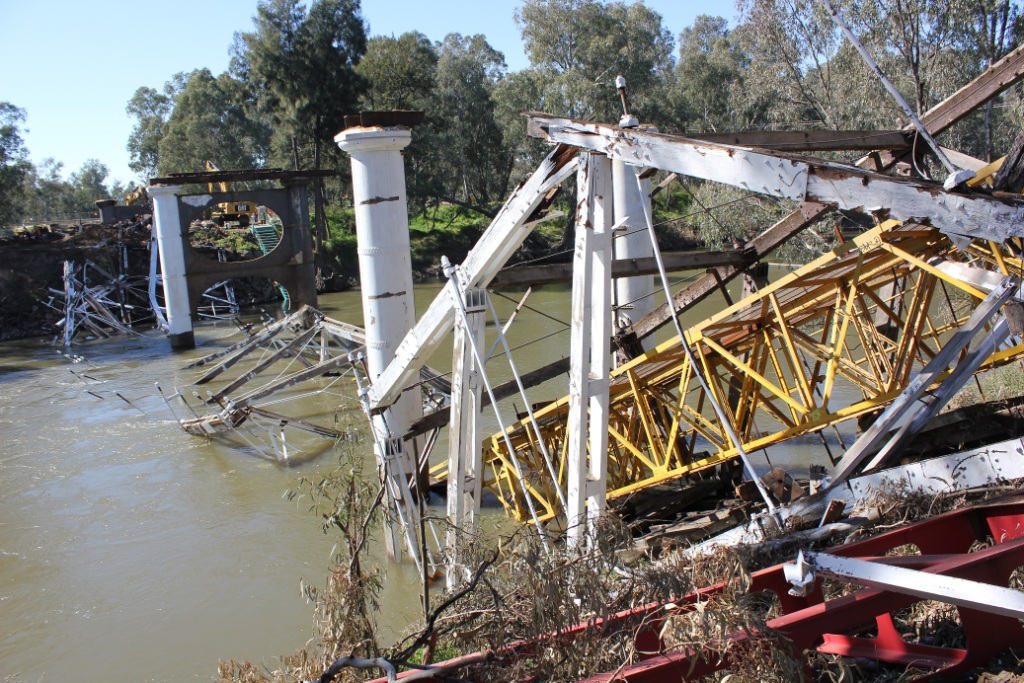
Following the induced collapse on 20 August, the contractor began removing span 3 truss members from the eastern bank and the river bed. This work was completed late on Friday. Up to 3 excavators at a time were used to remove the truss from the river and river bank.
Engineers have commenced inspecting and marking the truss timbers. The intention is to salvage one or two good examples of each truss member for perpetuity. Metalwork from the truss spans will also be salvaged. These include the cast irons shoes which join the diagonal members to the top and bottom chords, the vertical hanger rods, bracing, yokes and more.
Deconstruction of the span 1 truss has commenced with the contractors oxy cutting sections of the yellow frame off, as well as removing the truss timbers and metalwork.
A 30 T crane has established on the western bank. Span 1 truss components and yellow frame pieces will be transferred by crane to the barge. The barge will be floated across to the east bank and the materials unloaded.
Later this week, demolition of the pier 2 pylons will commence. The pylons will be hammered down using a rock hammer after the wrought iron casing is peeled away to expose the concrete within.
19 August 2014
With the deck having been removed, virtually all work is being undertaken from the barges. A second elevated work platform has been installed on one of the barges to allow for additional work to occur simultaneously.
Wrapping of the truss members which will have small explosive charges inserted is almost complete. The wrapping is intended to muffle the noise made by the initiation of the charges, as well as to contain any fly.
The diaphragm bracing between the two pylons at pier one has been removed. This is to allow span one, including the yellow frame to drop freely between the two pylons.
A great deal of rubbish was removed from the river bed to allow for removal of the demolished trusses from the water without being entangled in snags. Items have included bicycles, shopping trolleys and street signs. Some timber members possibly from Hampden Bridge or possibly from some other timber structure have also been removed.
11 August 2014
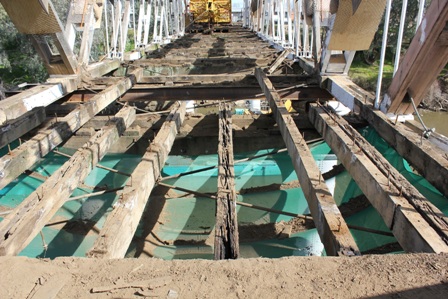
The timber deck is now completely removed. The last sections of deck were removed on Saturday. Also removed have been the stringers, which are the longitudinal pieces of timber the deck rests on.
The bridge has now been reduced to a "skeleton" consisting of the trusses themselves and cross-girders.
The other significant work that has occurred during the week is removal of snags from the river bed. The contractor has been removing timber, submerged trees, shopping trolleys and other items from the river bed which may hinder removal of the trusses once they are in the water.
6 August 2014
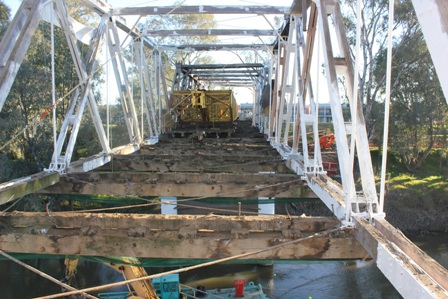
With the last two weeks being predominantly dry after a fair bit of wet weather, conditions have been good for most tasks. In particular, lead paint removal has been all but completed. There remains a minimal amount still to be removed on some upstream members.
Part of the lead paint management involves not removing the paint where it is still adhered well to the metal or timber. In this case, it is encapsulated using a sealer / binder. You will have noticed the piers are in the process of being painted white, as well as several timber truss members.
The Contractor has commenced using a "grab" attachment on the barge mounted excavator to search around on the bed of the river for submerged pylons and logs. The river bed needs to be relatively clear so that when the collapsed truss sections are removed from the river they can be removed as quickly as possible without getting snagged and caught up on existing debris which may be in the river. Because of the muddy water, this task needs to be methodically done by "feel" alone.
Sections of deck are now being removed. The BridgeWood (plywood) decking is being removed from the western end of span 2 as deck removal proceeds in an easterly direction. (refer photo)
The stringers are also being removed. Stringers are the longitudinal beams which support the deck and in turn rest on cross-girders. The cross-girders will remain and go down with the trusses. (refer photo)
The second concrete block or king post at the Fitzmaurice Street abutment has been moved back several metres from the end of the bridge. The king posts have had to be removed so they are not damaged during the induced collapse. These will eventually be refurbished and returned to their original positions.
22 July 2014
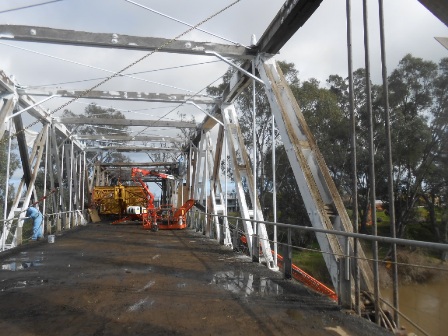
The contractor has been focussing solely on lead paint removal for the last week (refer photo).
With wet weather and high gusting winds during several days last week, conditions were not ideal for this work.
Removal of the last of the bitumen on the deck has been completed.
With improved weather early this week, lead paint removal has accelerated over the last couple of days. It is anticipated that lead paint removal will be completed towards the end of next week.
20 July 2014
The contractor responsible for the demolition of Wagga Wagga's Hampden Bridge has received approval to use the method of 'induced collapse' to remove the three main spans of the Bridge, with the collapse expected to occur in three to four weeks time.
'Induced collapse' is a common technique for bridge demolition and involves the sequential removal of key structural elements through the application of force in order to cause a controlled collapse of the bridge.
The initial methodology proposed by the contractor involved dismantling the bridge via large cranes located on the river bed and floating work platforms.
The contractor proposed the change due to concerns about the bridge's stability and the possibility of unplanned and potentially dangerous collapses occurring.
"The approval to change the demolition methodology allows the contractor to proceed with the works, with no impact on the overall project schedule or budget," said Director of Infrastructure Services, Heinz Kausche.
"Because the method of induced collapse relies on the remote application of force using small explosive charges embedded into key structural members of the bridge, the demolition will occur within a strict exclusion zone, approved and monitored by WorkCover NSW," continued Mr Kausche.
The exclusion zone will be put in place on the day of the demolition and prohibit public access to all areas within a significant distance around Hampden Bridge.
The exclusion zone will include road closures on Wiradjuri Bridge, Fitzmaurice Street and Hampden Avenue and will be clearly marked and strictly enforced on the day.
"We recognise that for community members interested in the project, the exclusion zone significantly limits the visibility of the project," said Mr Kausche. "However the exclusion zone is set by WorkCover NSW for the safety of the community and will be strictly enforced with no exceptions."
"Given the very limited viewing areas, Council is filming the demolition from a number of different angles and as soon as possible after the collapse will make the footage available online and to the media."
Further notification about the implementation of the exclusion zone will be provided as the project progresses.
Over the coming weeks work onsite will continue to focus on the removal of loose timbers and contaminated material, reducing the bridge to a skeleton structure before it is collapsed. Once collapsed, the structures will be dragged onto the embankment of the River where they will be safely dismantled.
4 July 2014
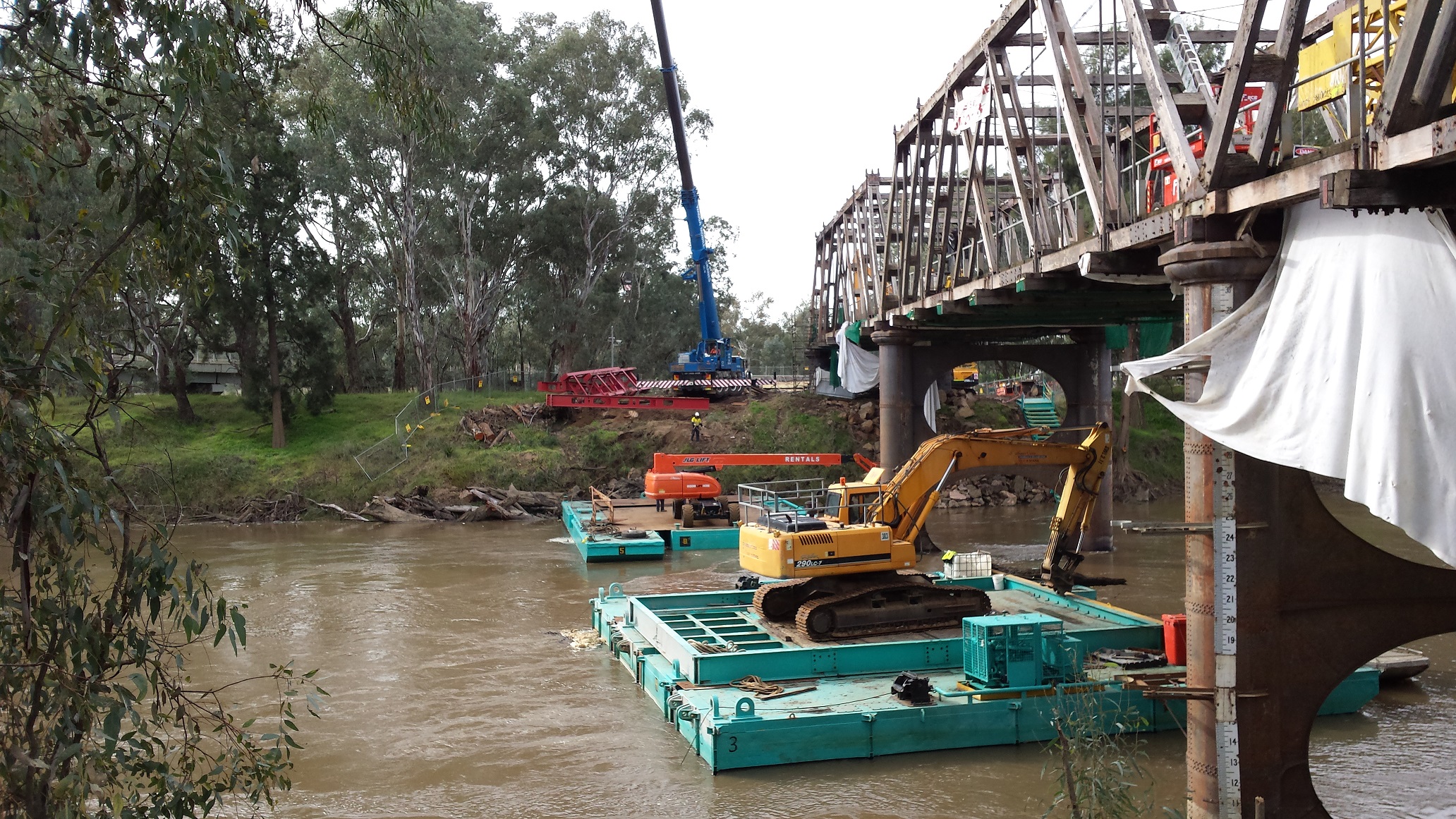
A 90 tonne and 30 tonne crane has been onsite over the past week to lift the support support frame components on to the barges (refer photo) and then into place under truss span 1.
The focus for the coming week will be installation and welding of the support frame to ensure the most unstable part of the structure is supported during the work and a safe worksite is maintained.
Wet weather during the last week has led to very little lead paint having been removed. A small quantity has been removed, and work will concentrate on lead paint removal in the very near future.
Lead paint will be removed from each span while the deck is still in place. Once lead paint is removed, the deck will sequentially be removed from the west side working towards the east.
The bitumen seal, decking bolts and most of the timber BridgeWood (plywood) decking will be removed from the bridge prior to the induced collapse. The removal of decking serves to lighten the load on the truss spans, and also will result in less material to be removed from the bridge once it is on the ground.
In the past week, decking panels have been removed from underneath the yellow iron support frame (installed on the bridge in 2006 to provide much needed stabilisation to the ailing structure). The yellow frame will remain in place while the bridge is demolished.
20 June 2014
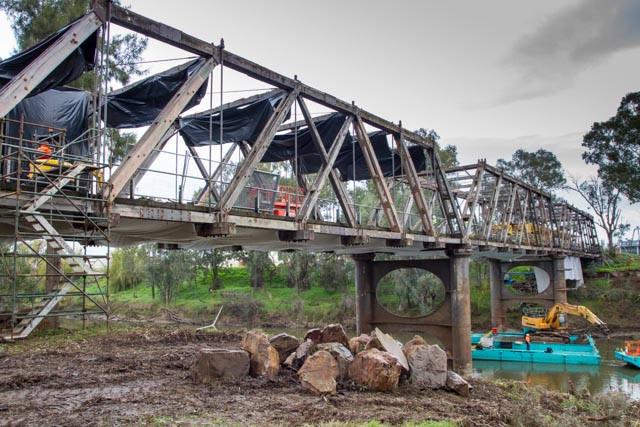
Hampden Bridge's distinctive shape is provided by the three large, angular timber trusses, and is synonymous with Percy Allan timber bridges of the time. The project refers to the three remaining truss spans as Truss Span 1 (closest to Fitzmaurice Street), Truss Span 2 (centre truss) and Truss Span 3 (closest to North Wagga).
In the past week removal of the asphalt layers on the deck of the three main truss spans of Hampden Bridge has commenced.
The bridge's walkway and top chords are now completely removed, exposing more of the bridge's skeleton.
In the coming week, the slow tasks to progressively remove the decking bolts and lead paint will commence. Lead paint removal will be undertaken principally by paint scrapers to remove flaking paint and captured in a containment system using tarp, as seen in the picture above. Where lead paint is sound, it will be painted over to encapsulate the lead underneath an approved sealer / binder paint.
Minor excavation completed under truss span 1 will allow a frame to be constructed under the truss to ensure the most unstable part of the structure is supported. Although this may seem at odds with a demolition project, it is important to maintain a safe worksite throughout the preparation stages and ensure any collapse is strictly controlled.
Wet weather and resulting access issues is hampering the removal of material off site.
12 June 2014
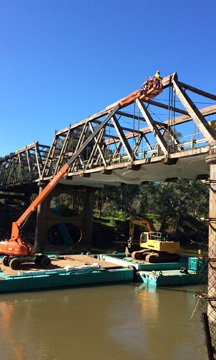
All nine approach spans from Hampden Avenue were removed last week, with the timber removed off site to accredited timber recyclers or waste disposal centres.
Iron flashing and the top chords were removed early this week via the scissor lift (see photo) located on the floating work platform, as part of the work to reduce the bridge to a skeleton structure prior to ultimate removal.
River users are reminded that due to the potential to affect the safety of navigation, Roads and Maritime has declared the work area a Special Event and an Exclusion Zone. The exclusion zone is on navigable waters of the Murrumbidgee River 500 metres either side of the Hampden Bridge until 29 August 2014.
The exclusion zone is clearly marked with yellow aqua-markers. In addition, floating booms are in place closer to the bridge as physical barriers.
Roads and Maritime have advised that no unauthorised vessels are permitted to enter the Area and to do so may be an offence under the Marine Safety Act 1998, s.12(6) which has a Maximum Penalty $1,100.
Safety testing of the supporting structures is continuing in the coming week prior to further work on the main three spans. Results of the testing may require additional propping structures to be put in place to allow safer access to the work area.
The request to amend the Demolition Methodolgy in the current approved Development Application is on public exhibition from Friday 13 to Friday 27 June. Residents can review the application at Council's Customer Service Desk.
The initial work being undertaken over the coming months is common to both current and changed methodology, allowing the amendment to be assessed without further delaying the project.
Due to common works involved in site preparation, no unnecessary work is being undertaken, nor is contractor operating outside current conditions of consent.
The amended application proposes 'Induced collapse' - a common technique for bridge demolition that removes the need for intensive work on unstable structures at height and reduces the possibility of truss failure during manual dismantling.
Induced collapse involves the systematic/sequential removal of key structural members through the application of force to result in the controlled collapse of the structure.
Because the application of force to remove key structural members is done remotely via the use of small charges, this method minimises the need for prolonged work activity by individuals on a deteriorating and dangerous structure.
Additionally, the structure is collapsed to ground level where it can be then dismantled on the ground rather than trying to dismantle them at height.
5 June 2014
The nine timber spans on the eastern approach to Hampden Bridge are being progressively removed this week. Working from Hampden Avenue, metal bolts and plates are removed prior to dismantling the decking and supporting timbers.
Surface contaminants continue to be removed or contained across the entire bridge surface.
Bat exclusion measures are in place and include shadecloth wrapping the underside and flood lights. The cloth is checked morning and night to ensure the Bridge has not become home to any part of the bridge prior to removal.
Working on an ageing and unstable structure brings many challenges and risks. The contractor uses the floating work platforms under the bridge to access the bridge where possible and limit equipment on the decking itself. In areas of greater concern, the contractor is currently ensuring adequate support structures are fitted where required to enable further bridge work to continue.
Due to the heavy contamination of the bridge material, Council is not able to distribute any of the structures to third parties for re-use due to the potential risks to human health and/or the environment. The material being removed from the site is being transported to accredited waste disposal sites, and is subject to the waste management parameters outlined in the Contamination Assessment.
Although material cannot be freely distributed to third party individuals, the potential for re-use of recovered material to appropriately commemorate the bridge site and community connection to the bridge has been a key consideration of Council.
Through the Heritage review process, Council has an identified listing of significant heritage items and bridge material that will be retained within the strict parameters for the management and distribution of bridge timber. This listing has been created in consultation with Museum of the Riverina, Engineers Australia, NSW Office of Environment and Heritage and Council staff.
29 May 2014 The Hampden Bridge Project commenced on the 15 May with the establishment of a work site around the bridge itself, creating safe access off Hampden Avenue and placing additional fencing around the approach to the bridge on the North Wagga side.
The work site also includes the River itself, with two large barges floated into place under the bridge to form work platforms. The barges were anchored into place on Saturday 24 May and will be used to enable machinery and workers to access the bridge safely, without the need to be on the unstable bridge structure itself.
This week workers have been using lifts and equipment located on the barges to access the bridge structure to remove the handrail and walkway.
In the coming week, surface contaminants such as lead based paint, will be removed or contained, bolts that connect the decking to the girders will be removed and shadecloth will then be used to wrap parts of the underside of the bridge to deter any bats from living in the bridge.
The first sections of decking and trestles in the eastern most approach from Hampden Avenue will then be progressively removed from east to west over the next two weeks.
Time lapse cameras have been set up on site to monitor the project as well as provide a visual record that will be packaged up on a regular basis for media and community viewing.
Below: Barges are floated from Wiradjuri Boat Ramp into place under the Hampden Bridge, forming a work platform.
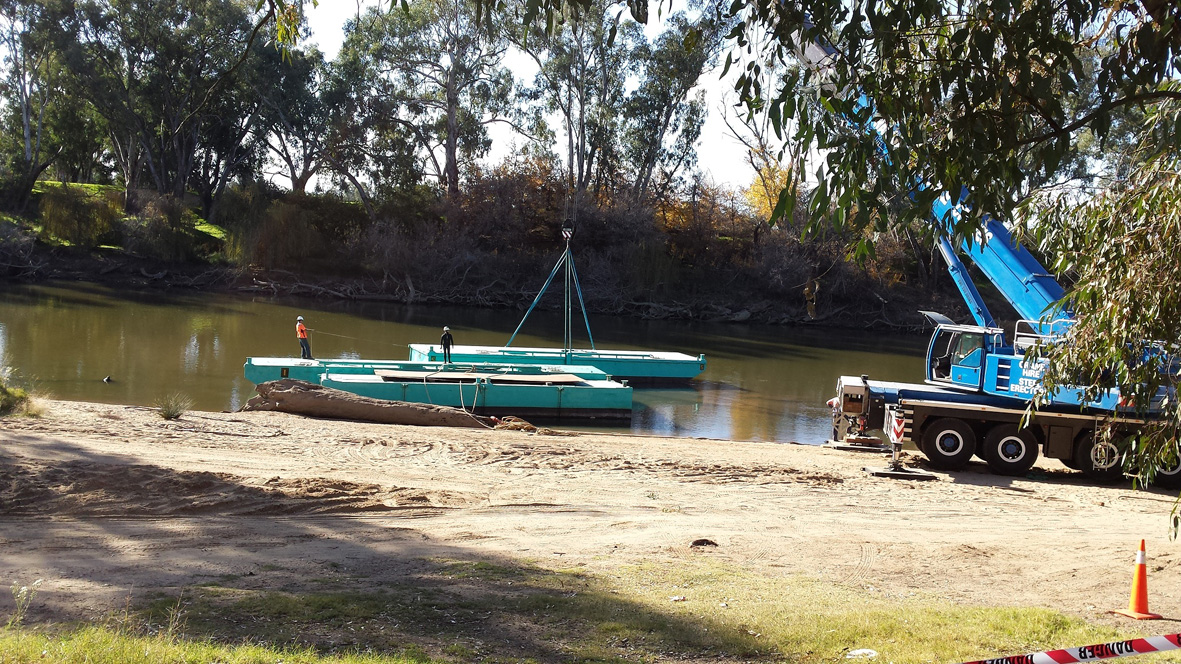
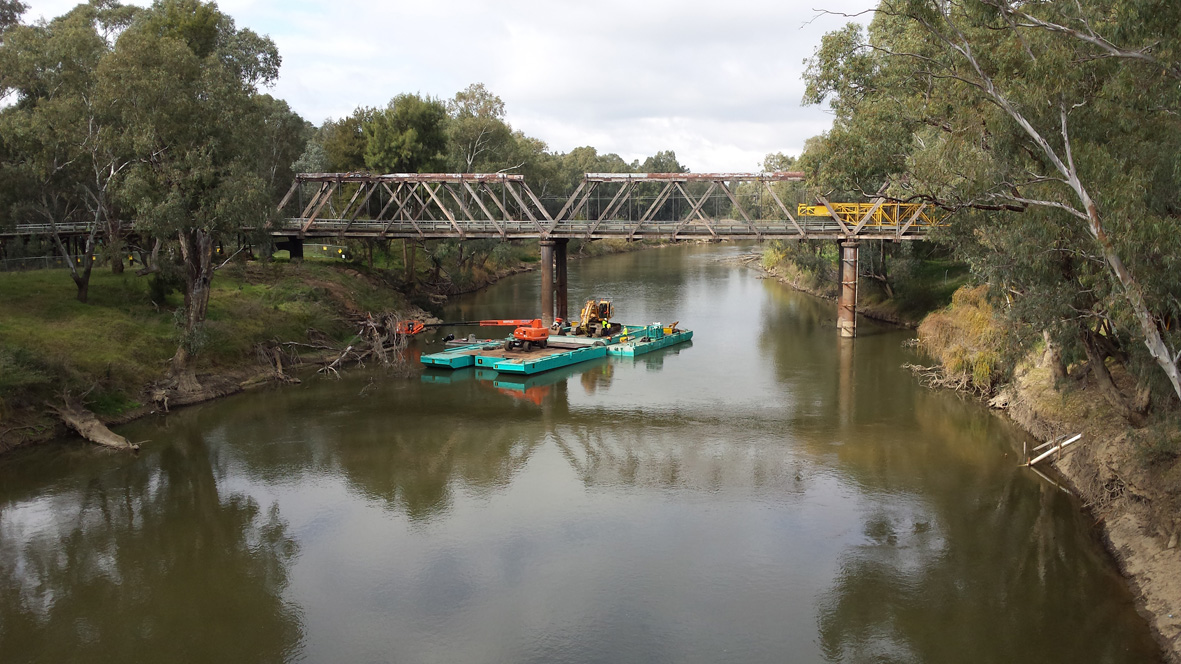
22 May 2014 - Hampden Bridge Project - Update
Information update on the Hampden Bridge Project, including:
- Site establishment and next stages of work
- Demolition Methodology
- Proposed change of methodology
- Pylon removal
- Retention of timber for heritage purposes
- Ongoing communication
14 May 2014 - Preparation for Hampden Bridge Project commences
Contractors responsible for the removal of Hampden Bridge will this week move equipment into place on the Murrumbidgee River and establish a safe work site around the Bridge in preparation for the commencement of work.

